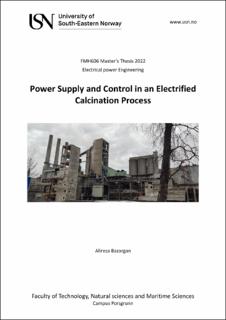| dc.description.abstract | Summary: Concrete as a building material is crucial in today's construction process. However, cement production, which acts as a glue in the concrete, leads to 5 o 7 % of the world's -emissions yearly [1]. In the Paris agreement, which has189 signatories, governments decided to take global action in a determined way to reduce greenhouse gas emissions to limit the global temperature below 2 °C to avoid environmental, economic and social costs and harms [2]. Nearly 65% of is produced in the calcination process, and 35% of the results from fossil fuel consumption for the required thermal energy for calcination. In the existing production system, the exit heat from the kiln is used for preheating the raw material. Norcem as a pioneer company, is planning to electrify the calcination system to capture pure . The electrification of the process needs 77MW electrical energy. In this study, a phase control SCR power supply is designed. Silcon Carbide heating elements is used for heating production. increase in the resistance of the heating element during operation by time, temperature limit of the heating elements, current harmonics are the main objectives that needs reserve voltage, power control and harmonic filtering systems respectively. A three windings furnace transformer is applied to provide the reserve voltage, and SCR/thyristors (Triac) is used for power control and single LC filter is used for harmonics issues.
Dymola is a simulation tool which is used for this study. Effect of Delta/Star connection of the heating elements, Vector group of transformers on the harmonics, Cable sizing are studied. A 100 MVA power substation is being considered in the factory to feed the company. The results of the study show that there are some concerns about Silicon Carbide heating elements that are an economic issue. These types of heating elements must be replaced with new ones when they reach the maximum limit of its resistivity. Also, for high power consumption of the project, the local electric authority must provide a high voltage line to the company. The cost of the project is high, and the efficiency of the method needs to be studied more. | |
